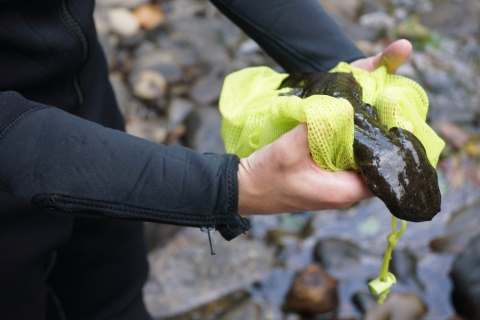Depicted as vermin and strange creatures by European settlers, eastern hellbenders faced extermination by fishermen, dissection by academic institutions, and consumption by high-society clubs from the 1800s to the mid-1900s. Fortunately, the U.S. Fish and Wildlife Service, tribal agencies, state wildlife agencies, and others have come to their defense.
At one with their habitat
Eastern hellbenders (Cryptobranchus alleganiensis alleganiensis), North America’s largest salamander, can reach two feet in length and live up to 40 years. They are fully aquatic and cannot survive out of water. They spend most of their lives nestled underneath streambed rocks.
Hellbenders use their rudder-like tails to swim and their robust legs to walk along streambeds while hunting for tasty crayfish, tadpoles, and snails. They have lungs that help them float but breathe through the pores in their dark, wrinkly skin.
According to Service biologist Noelle Rayman-Metcalf, hellbenders serve as an important indicator species for water quality, as they prefer streams that are clean and well-oxygenated. They help maintain freshwater ecosystems by keeping crayfish, other macroinvertebrates, and fish populations in check. In turn, they serve as prey for larger fish, great blue herons, raccoons, minks, and river otters.
Assailed from all sides
Unfortunately, their strange looks and habits no doubt played a role in the mistreatment hellbenders endured in the 1800s and 1900s.
Known to Indigenous peoples long before European settlement, eastern hellbenders were first documented by western scientists in Virginia in 1801. During the following century, hellbenders faced large-scale commercial killing due to the misconceptions that they were venomous, hard to kill, and responsible for decimating sport-fish populations through consumption of trout and their eggs.
Robin Foster, assistant professor of animal behavior, conservation behavior, urban ecology and herpetology at Canisius College in Buffalo, New York, has been researching eastern hellbenders through archival sources since 2004 and shared some of her findings.
Articles in the early 1800s recommended killing hellbenders by shooting them three times with a musket or chopping their heads clear off! When fishermen did catch hellbenders, they would bring them to local news reporters to have their pictures taken with the strange creatures.
High-flying societies in New York City were also after the curious creatures. The Ichthyophagous Club sought to taste-test different aquatic species and listed hellbenders — along with sea robins, skate, and toadfish — on their menu published in The New York Times in 1881.
Hellbenders were also collected for scientific study. In 1921, a college student, Paul A. Webb, paid his way through university by selling hellbenders to academic agencies and zoological societies as dissection specimens. Binghamton University in New York conducted hellbender dissections as late as 1966. Hellbender specimens were in demand by many museums, including the Smithsonian in Washington, D.C. Collection events such as these no longer occur.
Scientists noted a decline in hellbender populations in the 1920s. Still, they were hunted commercially into the 1930s in the Northeast. Hellbender hunting was even rewarded in one state, where “Wanted Dead” posters and bounties for hellbenders were common in the mid-1900s.
The commercial killing of hellbenders slowed when a pair of brothers, one a herpetologist and one a biologist, gave a presentation to the Pennsylvania Fish Commission in 1938 stating that hellbenders were not the enemy of sport fish and were actually beneficial for freshwater ecology.
In addition to direct harm, hellbenders endured an indirect assault from the Industrial Revolution. By the mid-1800s, the steel industry, dam construction, and logging had polluted waterways in New York, Pennsylvania, and other northeastern states, damaging their habitat.
“It was another punch in the gut to hellbenders,” said Foster. “They really faced one thing after another.”
Hellbender populations continued to decline until the passing of the Clean Water Act in the 1970s brought efforts to restore the nation’s waterways.
Lending hellbenders a hand
While scientists still consider removal of hellbenders from streams a threat to their survival, there is some level of protection for them across all of their range. Eastern hellbenders are listed as either endangered or threatened in many states within their range. In New York, they have been considered a species of special concern since 1983.
The U.S. Fish and Wildlife Service recently reviewed the federal status of the eastern hellbender, and proposed protecting the Missouri population. However, the agency also recognized that other populations, while not threatened or endangered, were at risk and would benefit from conservation.
Current threats facing hellbenders include warming waters, channelization, and sedimentation in streams. Conservation actions that are taking place include permanently protecting riparian riparian
Definition of riparian habitat or riparian areas.
Learn more about riparian areas along rivers and streams, placing large rock slabs into rivers and streams to increase available nesting habitat, and abating stream erosion that causes banks to crumble into the water adding sediment that covers up their nest rocks.
In New York, the Service has partnered with The Wetlands Trust, SUNY College of Environmental Science and Forestry, Lycoming College, and the Bronx Zoo to raise young hellbenders in a new facility dedicated to captive rearing. When they are large enough to be relatively safe from predation, the hellbenders are released into the wild.
Looking past appearance
The eastern hellbender has faced a lot in the last couple of centuries. Whether or not it wins a badge in beauty, this resilient salamander deserves recognition and respect.
“During my studies, it was concerning to see evidence of population declines in a species so long-lived and well-adapted to its environment,” said Foster.








